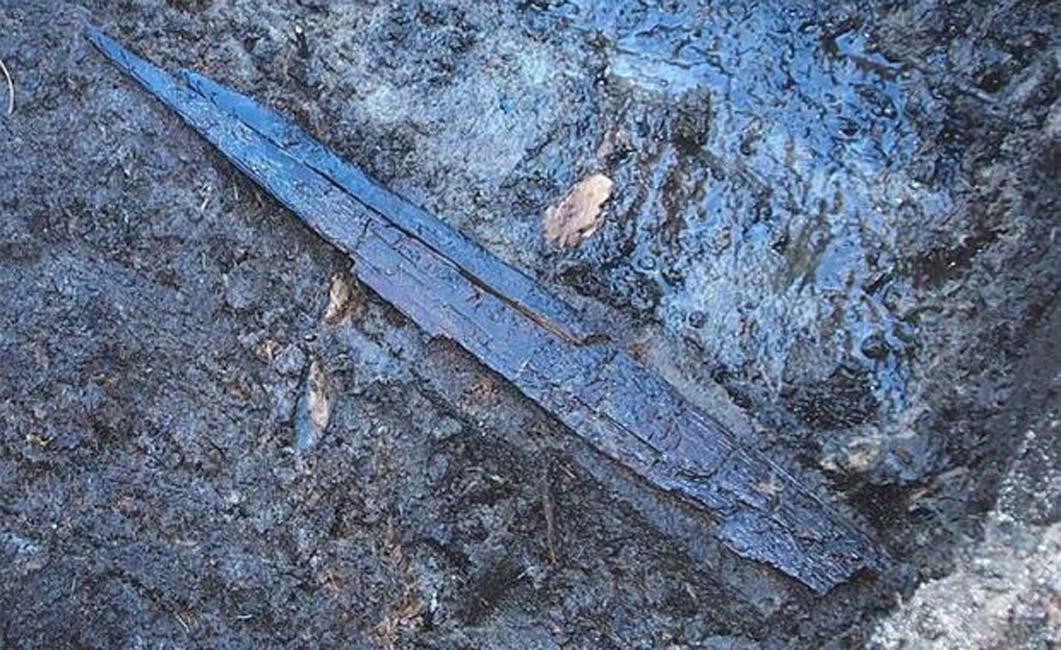A unique wooden spear from 7000 BC has been discovered in Bolków near Świdwie lake in Western Pomerania in Poland. It is the only known artifact of its kind in Europe.
The spear had been hidden one-meter (3.3 ft.) underground. Its shape reminds one of a long oar. According to Gazeta Wyborcza , the piece is well preserved and measures about 40 cm (15.7 inches) long and 10 cm (3.9 inches) wide. It was made of wood from an ash tree (Fraxinus). The discovery took place at the site of a 9,000-year-old sanctuary.
The spear is unique due to its age, but also for its impressively rich decoration full of geometric and zoomorphic symbols, as well as ritualistic scenes. These carvings led researchers to conclude that the spear was used during mysterious Mesolithic rituals performed by the people who lived in the settlement near the lake. The spear was examined by X-ray and the results showed different combinations of geometric sequences and also carvings of humans and animals.

The wooden spear found near Lake Świdwie, Poland. ( T. Galiński )
According to the leader of the research group, professor Tadeusz Galiński from the Szczecin branch of the Institute of Archaeology and Ethnology PAS, it is very common for Mesolithic societies to decorate tools and other manmade items. Archaeologists have found similar carvings on items made of bone, wood, amber, and stone in Bolków and other parts of Europe. The scenes depicted on the items are evidence for the rich belief system that existed in these societies.
- Mesolithic sanctuary reveals evidence of ritual and astronomical practice
- Mysterious medieval fortifications buried in Poland detected with advanced imaging technology
- The Hidden Story of Poland: What Happened to the Forgotten Kingdom of Lechia?
The main scene depicted on the spear is a ritual scene with three people – one of them is presented in a characteristic ritual mask with deer horns. The researchers believe that he may have been a shaman for the tribe. The second person is presented nude and is dancing. The third person is dressed in a long cloth and holds something in his/her hands - probably and offering to the gods.

An illustration of a shaman in Siberia, produced by the Dutch explorer Nicolaes Witsen in the late 17th century. ( Public Domain ) Note the typical deer antler headdress.
Another detail is a visible carving of a settlement. Among other images, the researchers saw forest animals and birds. There is also a sequence of unknown symbols, which the researchers think could have been some sort of spells.
The first evidence of mysterious rituals in the area of the Mesolithic site at Bolków were unearthed in 2012. During the previous seasons the researchers discovered a wooden censer, which was used for ritual smoking to drive off evil spirits around places, people, and objects. Apart from this, they identified a bundle of pieces of wood, bark, herbaceous plants, and animal bones which could have been a shaman's offering. As Prof. Galiński told PAP : "Sacrificial offerings were an expression of belief in supernatural powers and forces of nature. Their purpose was to appease deities. They were made on behalf of all residents and members of the group with the participation of the spiritual leader."

A wooden censer previously found at the site. ( T. Galiński )
The area of the sanctuary is a circle with a diameter of approximately 6 meters (19.7 ft.). There are several large stones inside, and many other smaller stones around such as syenite, diorite, granite, quartzite, sandstone, gneiss, red marble, and green syenite. The most surprising of the stones that were discovered are black amber and the volcanic rock pumice. The excavation has already begun to change the history of these lands, however, the researchers assert that it still contains many secrets.
- Following the Magical Journey to Poland by John Dee and Edward Kelley
- A 1000-Year-Old Nordic Spearhead Raises the Question - Were The Vikings in New York?
- Early humans and the evolution of hunting skills

Excavating the site in Bolków, Poland. ( T. Galiński)
Although the spear discovered in Poland is the oldest of its kind in Europe, on August 31, 2016, Ancient Origins reported on ritual tools that are even older and have already have changed history. As Natalia Klimczak wrote:
''A remarkable collection of etched limestone pebbles may change our knowledge of prehistory in the Levant. Moreover, a beautiful head of a bird, which was carved into a limestone plaque 16,500 years ago, may be among the oldest ritual objects ever found in the Levant.


No comments:
Post a Comment